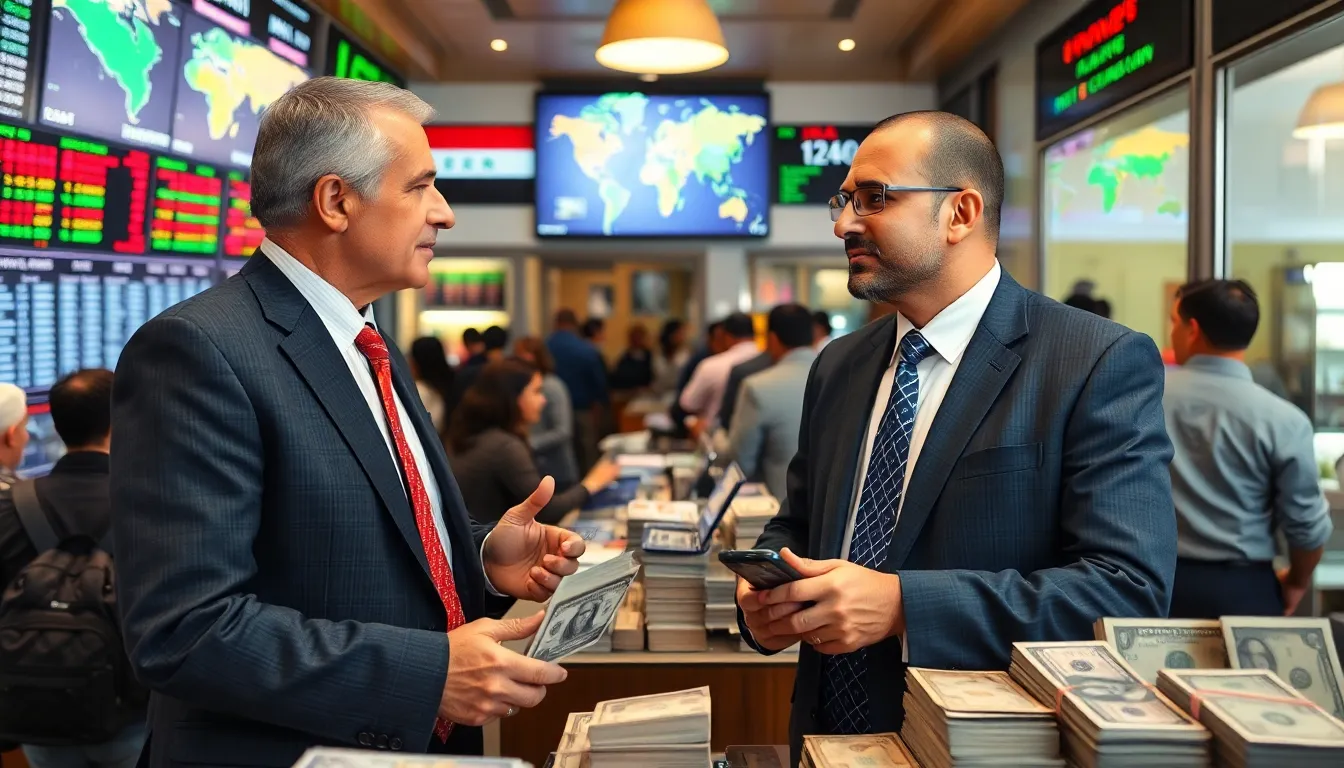As the global economy continues to evolve, currency exchange rates remain a focal point for investors and businesses alike. The USD to IQD exchange rate in May 2025 is poised to capture significant attention, especially for those engaged in trade or investment in Iraq. Understanding this exchange rate is crucial for making informed financial decisions.
Several factors could influence the USD to IQD rate, including geopolitical developments, economic policies, and market trends. With Iraq’s economy gradually stabilizing, predicting future exchange rates becomes increasingly important. This article delves into the potential fluctuations and trends that may shape the USD to IQD exchange rate in the coming years, providing insights that can benefit both investors and travelers.
Table of Contents
ToggleOverview of USD to IQD Exchange Rate
The exchange rate between the US Dollar (USD) and the Iraqi Dinar (IQD) serves as a barometer for economic health and trade dynamics. Exchange rates vary continuously due to market forces such as supply and demand, inflation rates, and interest rates. In May 2025, specific factors could influence the USD to IQD exchange rate.
Market conditions play a crucial role in shaping the exchange rate. Economic forecasts highlight reliance on oil prices, as Iraq’s economy depends heavily on oil exports. Oil price increases typically strengthen the IQD, while declines may weaken it.
Geopolitical developments also impact exchange rates. Stability in the region can lead to confidence in the Iraqi economy, whereas conflict or uncertainty may result in a weaker IQD against the USD. Foreign investment patterns reveal an essential connection between political stability and currency strength. Increased foreign investment often bolsters the IQD.
Additionally, Iraq’s monetary policy affects the USD to IQD exchange rate. The Central Bank of Iraq’s interventions in the currency market through interest rate adjustments can stabilize or destabilize the exchange rate. Predictable monetary policies help build investor confidence.
Understanding historical trends provides further context. Tracking past exchange rates can reveal patterns and assist businesses and investors in strategizing for potential currency fluctuations in May 2025. Regularly reviewing market analyses and financial reports ensures informed decision-making in response to changing conditions.
Factors Influencing Currency Exchange Rates

Understanding the factors influencing currency exchange rates is essential for evaluating the USD to IQD exchange rate in May 2025. Various elements, including economic indicators and political stability, play a crucial role in shaping these rates.
Economic Indicators
Economic indicators significantly determine currency values. Metrics such as GDP growth, inflation rates, and unemployment figures provide insight into economic performance. For instance, a rise in Iraq’s GDP may strengthen the IQD as it signals economic expansion. Similarly, low inflation rates suggest stability, attracting investor interest. Regular updates from the Central Statistical Organization of Iraq can shed light on these indicators and their potential impact on exchange rates. Monitoring international oil prices is vital, as fluctuations directly affect Iraq’s oil-dependent economy, thereby influencing the IQD’s strength against the USD.
Political Stability
Political stability affects investor confidence and, consequently, currency valuation. A stable political environment encourages foreign investment, leading to a stronger IQD. Conversely, political unrest or uncertainty can lead to rapid currency depreciation. Key events, such as elections or changes in government policies, warrant close observation. Monitoring developments from reliable sources can help predict potential impacts on the USD to IQD exchange rate. Understanding the implications of geopolitical relations, especially with neighboring countries, is also essential for assessing future exchange rate trends.
Historical Context of USD to IQD Exchange Rate
The historical context of the USD to IQD exchange rate highlights significant fluctuations influenced by various factors. In 2003, the exchange rate saw dramatic changes following the Iraq War, which led to a shift from the Iraq dinar’s fixed exchange system to a floating rate.
Between 2004 and 2010, volatility characterized the exchange rate. The IQD depreciated amid ongoing conflict and political instability, dropping to around 1,500 IQD per USD. The period also witnessed attempts by the Central Bank of Iraq to stabilize the currency through monetary policies and currency auctions.
From 2010 to 2014, increased oil prices allowed for economic growth, strengthening the IQD to approximately 1,200 IQD per USD. The rise in oil revenues enriched the Iraqi economy, enabling better fiscal policies. However, the emergence of the Islamic State in 2014 disrupted gains, causing the IQD to weaken again.
In the years following, particularly from 2017 to 2021, Iraq’s economy faced challenges, including political uncertainty and fluctuating oil prices. The IQD stabilized around 1,460 IQD per USD as the Central Bank implemented measures to restore confidence in the currency, including interest rate adjustments and inflation control.
Throughout these historical fluctuations, external factors such as global oil markets and regional geopolitics played critical roles. Understanding these historical trends aids in predicting future exchanges, particularly as international perceptions of Iraq’s stability evolve. Regular market evaluations remain essential in assessing the currency’s performance moving into May 2025.
Predictions for May 2025
Predictions regarding the USD to IQD exchange rate in May 2025 rely on various analytical perspectives and market dynamics. These forecasts integrate economic indicators, geopolitical trends, and expert insights.
Expert Analyses
Experts suggest that the exchange rate may reflect gradual stability in Iraq’s economy. Analysts highlight that improved governance and economic reforms could bolster investor confidence. If Iraq continues to diversify its economy beyond oil, it might strengthen the IQD against the USD. Additionally, stabilization in surrounding regions may encourage foreign investments, further positively influencing the exchange rate.
Market analysts anticipate that Central Bank of Iraq policies, including interest rate decisions, could create a more predictable financial environment. Consistent policies may stabilize the exchange rate and attract foreign capital. Experts emphasize monitoring these trends closely to gauge their impacts on the exchange rate.
Market Trends
Market trends indicate that oil prices will significantly impact the USD to IQD exchange rate in May 2025. As Iraq’s economy heavily relies on oil exports, fluctuations in global oil prices directly affect economic stability. Higher oil prices may increase Iraq’s revenue, enhancing the IQD. Conversely, a decline in oil prices could strain the economy, leading to potential depreciation of the IQD.
In addition, consumer sentiment and international trade dynamics will shape market trends. Increased demand for Iraqi exports can strengthen the IQD, while persistent inflation or economic instability might weaken it. Monitoring these factors regularly is essential for anticipating rates and making informed investment decisions.
Potential Impact on Investors
Investors should consider the USD to IQD exchange rate’s potential fluctuations as they may influence investment returns. A stabilized exchange rate could signal increased investor confidence, leading to greater foreign direct investment in Iraq. In the event of favorable economic reforms and geopolitical stability, the IQD may appreciate, producing higher returns for those invested in local assets.
Investors focusing on the oil sector need to monitor global oil prices closely. As Iraq’s economy is oil-dependent, rising oil prices typically benefit the IQD. Conversely, declining oil prices threaten revenue streams, potentially devaluing the currency and impacting investments tied to oil assets.
Interest rate policies set by the Central Bank of Iraq also warrant investor attention. An increase in interest rates might enhance the attractiveness of the IQD, drawing more investment. Predictable monetary policies that focus on growth can create a stable investment climate, which encourages both domestic and foreign investments.
Economic indicators such as GDP growth, inflation, and unemployment rates provide valuable insights for investors assessing the exchange rate. Increased GDP growth often translates to a stronger IQD, attracting investor interest. Low inflation rates indicate economic health, which may result in enhanced investor sentiment.
Political stability remains critical for investors to watch. A stable political environment typically fosters investor confidence, enhancing the IQD’s strength. However, any political unrest could lead to depreciation, impacting investment returns negatively.
Investors should also stay informed through regular market analyses and financial reports. Monitoring these factors can help anticipate fluctuations in the USD to IQD exchange rate, leading to informed decisions that align with their investment goals.
The USD to IQD exchange rate in May 2025 presents both challenges and opportunities for investors and businesses. As Iraq’s economy shows signs of gradual stabilization and diversification, understanding the underlying factors influencing the exchange rate becomes crucial. Geopolitical stability and effective monetary policies will play significant roles in shaping investor confidence.
Monitoring oil prices and key economic indicators will be essential for anticipating fluctuations. A stable exchange rate could signal an attractive environment for foreign investment, while ongoing evaluations of market conditions will enable informed decision-making. Staying updated on these dynamics will empower stakeholders to navigate the evolving landscape effectively.



